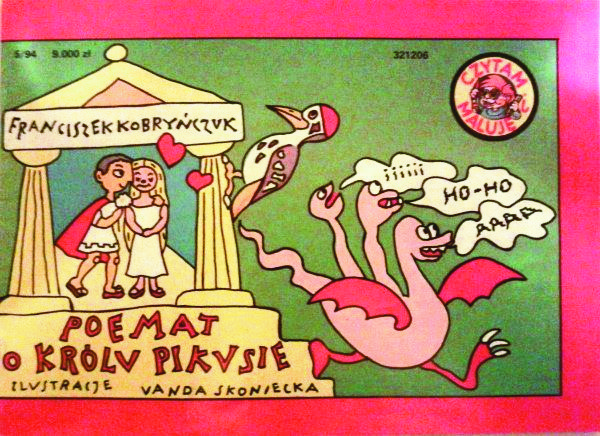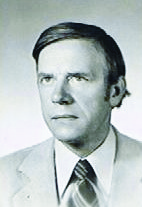Title of the work
Country of the First Edition
Country/countries of popularity
Original Language
First Edition Date
First Edition Details
Franciszek Kobryńczuk, Poemat o królu Pikusie, ill. Wanda Skoniecka, Czytam i maluję 5/94. Warszawa: Oficyna Wydawnicza Ostoja, 1994, 20 pp.
ISBN
Available Onllne
Poemat o królu Pikusie at ewa.bicom.pl (accessed: September 21, 2022).
Genre
Narrative poetry
Poetry
Target Audience
Children
Cover

Courtesy of the publisher.
Author of the Entry:
Maciej Skowera, University of Warsaw, mgskowera@uw.edu.pl
Peer-reviewer of the Entry:
Katarzyna Marciniak, University of Warsaw, kamar@al.uw.edu.pl
Elżbieta Olechowska, University of Warsaw, elzbieta.olechowska@gmail.com

Photograph courtesy of the Author.
Franciszek Kobryńczuk
, 1929 - 2016
(Author)
A veterinarian, professor of veterinary sciences specializing in animal anatomy (an authority on the anatomy of the Polish bison), writer, and poet. 1948–1950: a member of a secret youth organization active within the post-WW2 underground connected to Armia Krajowa [Home Army], banned by the Communist regime; in 1950 he was sentenced to a 10-year prison term for this activity; fully exonerated after the fall of Communism. Graduated from the Faculty of Veterinary Medicine of the Warsaw University of Life Sciences (SGGW); from 1994 to 2000 Head of the Department of Animal Anatomy at the same University. Debuted as an author for children in 1958 with a short poem Sowa [Owl], published in children’s magazine “Miś”; contributor to several other magazines for children and young adults, such as “Świerszczyk,” “Płomyk,” “Płomyczek,” and “Mały Apostoł”; author of about 30 books for children, young adults and adults; a former member of the Polish Writers’ Union; now his poems can be found most of all online. The page ewa.bicom.pl/wierszedzieci run by a Kobryńczuk’s admirer, Ewa Białek, functions as the official website for Kobryńczuk’s poems for children.
Source:
Materials kindly provided by the Author.
Bio prepared by Maciej Skowera, University of Warsaw, mgskowera@gmail.com
Summary
Based on: Katarzyna Marciniak, Elżbieta Olechowska, Joanna Kłos, Michał Kucharski (eds.), Polish Literature for Children & Young Adults Inspired by Classical Antiquity: A Catalogue (accessed: June 11, 2021), Faculty of “Artes Liberales”, Warsaw: University of Warsaw, 2013, 444 pp.
Picus, son of Saturn, the first king of Latium, is very rich and likes to hunt. In a forest, he meets a nymph called Canens. They fall in love and marry. Later, the witch Circe watches Picus and falls in love with him but the king refuses to become her husband; scorned and furious Circe takes her revenge by turning him into a woodpecker. The poem is illustrated with black and white images that children can colour.
Analysis
Franciszek Kobryńczuk begins this poem with a parenetic description of Picus, emphasizing his courage, strength, hunting skills, and the wealth of his royal court, along with information about his semi-divine origins and the fondness with which the nymphs held him. For this, the author repeatedly uses enumerations, one of the most common literary devices utilized by this writer. In the second part of the poem, he devotes the most space to one of the themes he looks at particularly often in his lyrics: the metamorphosis of man into an animal (woodpecker) due to the actions of a divine being. Interestingly, the poem starts with the fairy-tale-like initial formula: “Beyond the mountains, beyond the forests,”* and the lyrics are directly referred to herein as a “fairy tale.” Also interesting is the end of the poem, which expresses the belief that someday the woodpecker will again become the king of Latium. It also includes an ecological message: “Let’s make sure that by then no one will have destroyed our forests, my friends!”. In this way, the re-told mythological story becomes a call to care for nature, perhaps to be read in the context of the repeated hunting of Picus as an action that affects the ecosystem.
* All quotations translated by Maciej Skowera.
Further Reading
Harris, Rendel, “The Woodpecker in Human Form”, Bulletin of the John Rylands Library 5.5 (1920): 480–496 (accessed September 13, 2022).
Nosek, Anna, W przestrzeniach universum i regio. Wiersze dla dzieci współczesnych pisarzy regionu podlaskiego – interpretacje [In the Spaces of universum and regio: Poems for Children by Contemporary Writers of the Podlasie Region – Interpretations], Białystok: Wydawnictwo Uniwersytetu w Białymstoku, 2015.


